History of Banned, Racist and Censored Cartoons
Between 1930 and 1950, animators at Warner Brothers, Walt Disney,
MGM, Merrie Melodies, Looney Tunes, R.K.O., and many other independent
studios, produced thousands of cartoons containing racial stereotypes
and references to alcohol, adultery,
female anatomy, cross-dressing, gambling, marijuana, pornography, sexual
situations, smoking, and suicides (i.e. a
frustrated Bugs Bunny blows himself up).
This period is now known as the golden age of animation, and until the mid 1960s, cartoons were screened before all feature films. Later, these same cartoons would cycle endlessly for decades on broadcast TV or cable syndication. To modern
audiences, many of these cartoons are quite shocking and graphically illustrate how pervasive and institutionalized racism
was in our culture just a short time ago.
Ownership of Warner Bros. cartoons passed
to United Artists in 1968 and they created a "Censored
11" list of cartoons
they refused to air or make available for purchase on any media.
Since then, because of objections by parents, sensitive sponsors, timid corporate policy, and
changing cultural
mores, many more classic cartoons were heavily edited or pulled from syndication. Many
have already been lost forever.
Studios are so protective of their classic characters
like Bugs Bunny that in 2000, when Spike Lee made Bamboozled (a film dealing extensively with black stereotypes in Hollywood), Warner
Bros/United Artists denied his request to include images of Bugs in
blackface from the classic wartime cartoon Any Bonds Today. In 2001, the people at Cartoon Network announced a
"June Bugs" marathon, where they promoted their intention to
show every single
Bugs Bunny short. Warner
Bros/United Artists quickly stepped in and dictated to Cartoon Network
which shorts could not be shown.
These cartoons, like the cliché goes, were a product of their times and represent a period of
American history where views were very different than they are now.
While they are certainly not suitable for viewing by children without
adult supervision and guidance, they are important historical documents
that should be available to all. They are necessary for the development
of anyone's cultural and historical literacy.
It is
also important to
remember that they were intended to be funny, not hurtful.
One does not have to look far to find many other examples of racial stereotyping in popular media
in the first half of the 20th century.
Radio shows, movies, and comic strips were filled with caricatures of
Blacks, Native Americans, Hispanics, Asians, Jews, and many other ethnic
groups. It is to our great credit that we have evolved as far as we
have since
then, but we should preserve our history and not try to rewrite it in some
Orwellian attempt to excise those parts of it that we now find abhorrent.
|
Some examples of Banned, Racist and Censored cartoons:
Coal Black and de Sebben Dwarfs (1943)
A mammy tells her Honeychile the story of a very sexy So White and her Prince
Chawmin, who has two dice for front teeth. The Prince courts So White, and they boogie by moonlight. The queen is upset, and calls Murder Incorporated to “black out So White”. They advertise that they rub out anyone for a dollar, midgets 50 cents,
and “Japs” for free. The thugs kidnap So White, but drop her off unharmed, after being plastered with kisses. So White finds her way to a cave, encountering de Sebben Dwarfs. The dwarfs are all in the army now, and So White becomes the cook for the whole army camp. The queen disguises herself and gives So White a poisoned apple, then is
dispatched by a shell fired by the dwarfs. Prince Chawmin’s kiss is unable to revive So White,
but the “Dopey” dwarf succeeds. How? “Dat’s a military
secret!" |
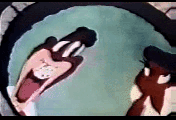
Coal Black and de Sebben Dwarfs (1943)
|
Jungle Jitters (1938)
African savages with humongous lips sing and dance. A traveling salesman
tries to peddle his wares to the natives, but soon finds himself in a cooking pot. |
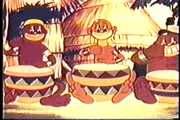
Jungle Jitters (1938)
|
The Isle of Pingo Pongo (1938)
The islanders are primitive savages, but they know the words to “She’ll Be
Comin’ ‘Round the Mountain” and “Sweet Georgia Brown”. They are
all drawn with small craniums, big lips, and bones in their hair. |
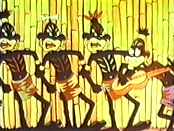
The Isle of Pingo Pongo (1938)
|
All This and Rabbit Stew (1941)
A slow-talking black boy modeled on a "coon" stereotype
made famous by Stepin
Fetchit, tries to capture Bugs Bunny. Bugs outwits, tricks, and dances his way to safety
time and again. Finally, the boy gains the upper hand, but Bugs
distracts him by rolling some dice. Bugs cleans the boy out while
playing craps; mimicking the boy’s clothes, posture, and speech
patterns.
|

All This and Rabbit Stew (1941)
|
Private SNAFU
The Private SNAFU cartoons were a series of army training films
produced during WW2 and used to warn soldiers against potential strategic or hygienic hazards. ("SNAFU" was military slang for "SITUATION NORMAL: ALL F***ED UP.") Produced by the Warner Brothers cartoon unit, these shorts were intended for viewing by the military only, so an unsuspecting animation fan will be taken aback to hear "hell" and "damn" frequently on the soundtrack, to say nothing of the references to female
anatomy.
Booby Traps (accent on booby) Spies, Operation Snafu,
and Snafuperman also contain less-than-flattering interpretations of German and Japanese enemy agents.
|
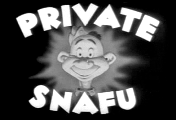
Private SNAFU
|
Bugs Bunny Nips the Nips (1944)
Bugs is trapped on a deserted island and has to grapple with a ridiculously stereotyped Japanese--short, buck teeth, big round glasses, slanty eyes and all.
"Japs!" screeches Bugs. "Hundreds of them!" Bugs also went up against Hermann
Goring in Herr Meets Hare (1945). Even earlier, Stalin, Hitler and Hirohito came in for some extreme stereotyping in 1941's
The Ducktators.
|
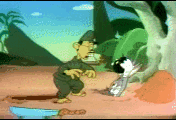
Bugs Bunny Nips the Nips (1944)
|
|
Visit
Blackface!
Learn more about racist Black stereotypes
that originated in minstrel shows |
 |
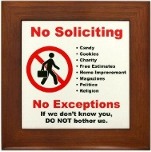
Buy a No
Soliciting Sign
That Really Works!
|








